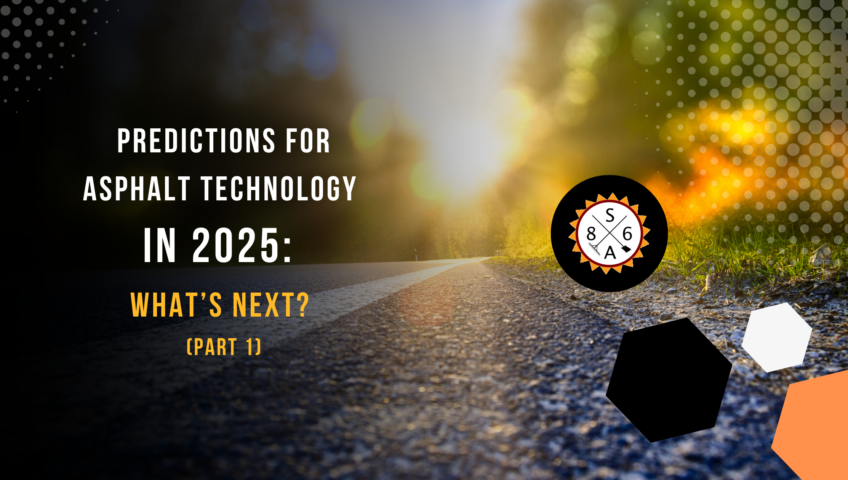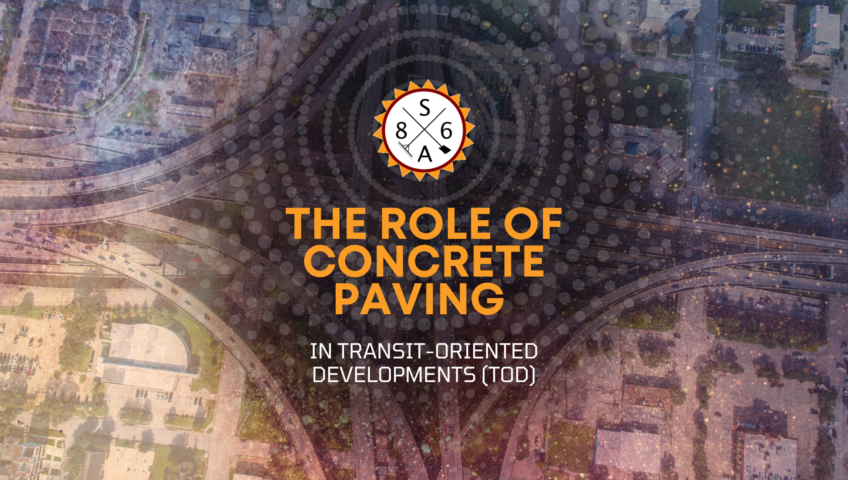
Predictions for Asphalt Technology in 2025: What’s Next? (Part 1)
Asphalt technology has seen significant advancements over the past few years, and 2025 is set to be no different. With the increasing focus on sustainability, cost efficiency, and infrastructure longevity, the asphalt industry is poised to embrace innovations that will further revolutionize the way roads are constructed and maintained. Below are some key predictions for asphalt technology in 2025, focusing on cutting-edge developments that will likely shape the future of the industry.
1. Self-Sustaining Roads Powered by Energy-Harvesting Asphalt
By 2025, the idea of energy-harvesting asphalt, which was once a concept, may become more mainstream. This innovation involves incorporating piezoelectric materials into the asphalt mix, which can convert the mechanical stress from vehicle traffic into electrical energy. While energy-harvesting asphalt is still in the research phase in 2024, advances in material science could lead to the commercialization of this technology.
Imagine highways generating electricity as vehicles pass over them, providing power to streetlights, charging stations, or even nearby buildings. This not only creates a sustainable energy source but also turns roadways into an active part of the energy grid, which could be particularly beneficial in urban settings.
2. Full Implementation of Smart Roads
The integration of technology into roadways is expected to accelerate in 2025, with more widespread use of smart roads. These roads will be embedded with sensors and IoT (Internet of Things) devices that communicate real-time information about traffic flow, road conditions, and maintenance needs.
By 2025, many major cities could start implementing roads that not only offer real-time updates to drivers about traffic congestion or accidents but also communicate directly with autonomous vehicles. These smart roads will be able to send data to connected cars, improving safety, optimizing traffic flow, and reducing fuel consumption.
Additionally, smart road technology will contribute to better maintenance, as sensors can detect small issues such as cracks or potholes before they become serious problems. This predictive maintenance approach will save municipalities millions in long-term repair costs and enhance road safety.
3. Widespread Adoption of Self-Healing Asphalt
While self-healing asphalt made its debut in 2024, its adoption is likely to expand significantly by 2025. The goal is to make roadways more durable and reduce the need for costly and disruptive repairs. By integrating materials such as microcapsules containing rejuvenators or steel fibers that can respond to heat or electromagnetic fields, self-healing asphalt will be capable of repairing cracks and minor damage automatically.
In 2025, municipalities and private road contractors may start using self-healing asphalt on a larger scale, especially on highways and major urban roads that are exposed to heavy traffic. This technology will help extend the lifespan of road surfaces, reduce maintenance-related closures, and cut down on the carbon footprint of asphalt production.
4. Carbon-Negative Asphalt
With the race toward carbon neutrality intensifying, the development of carbon-negative asphalt is expected to gain momentum by 2025. While carbon-absorbing asphalt started making headlines in 2024, the next step will be the creation of truly carbon-negative asphalt that not only captures carbon but also offsets more CO2 than it emits during its lifecycle.
This could be achieved through the incorporation of bio-based materials or the inclusion of advanced additives that bind and store carbon within the asphalt structure. Furthermore, asphalt plants may begin to adopt carbon capture and storage (CCS) technologies, which will reduce the emissions generated during the production of asphalt.
As governments push for stricter environmental regulations, the demand for carbon-negative asphalt will increase, creating a competitive market for eco-friendly infrastructure solutions.
5. Advanced Asphalt Recycling Methods
The use of Recycled Asphalt Pavement (RAP) has been steadily increasing, but in 2025, we may witness breakthroughs that make the recycling process even more efficient and widespread. Currently, the challenge with using high percentages of RAP is maintaining the same durability and performance standards as virgin asphalt. However, advancements in rejuvenators and mixing technologies could allow 100% RAP to be used in more demanding applications, such as highways and major arterial roads.
Moreover, closed-loop recycling systems may become the industry standard by 2025. In this system, asphalt is fully recycled on-site, reducing transportation costs and emissions associated with moving materials to and from recycling facilities. This approach could revolutionize the industry by making asphalt recycling faster, cheaper, and more environmentally friendly.
6. Ultra-Durable Asphalt for Extreme Weather
As climate change continues to cause more extreme weather patterns, 2025 will likely see further advancements in asphalt formulations designed to withstand these conditions. Ultra-durable asphalt mixes that are resistant to both extreme heat and freezing temperatures will be crucial for regions facing unpredictable weather.
New polymer-modified asphalts that incorporate advanced additives could offer better resistance to the thermal expansion and contraction that causes cracking. These materials will also have greater elasticity, allowing roads to remain intact despite shifting ground conditions or heavy rain.
In addition to extreme weather resistance, these new asphalt formulations will offer superior resistance to wear and tear from heavy traffic, making them ideal for use on highways, airports, and high-traffic urban areas.
The asphalt industry is on the brink of a technological revolution. By 2025, innovations in asphalt technology will focus on sustainability, longevity, and smart infrastructure. From energy-harvesting roads to ultra-durable, climate-resistant asphalt, these advances will transform the way we build and maintain roadways. As we move toward a more connected, environmentally conscious future, the asphalt industry will continue to innovate, paving the way for smarter, greener infrastructure.
Stay tuned for part 2!
Asphalt technology has seen significant advancements over the past few years, and 2025 is set to be no different. With the increasing focus on sustainability, cost efficiency, and infrastructure longevity, the asphalt industry is poised to embrace innovations that will further revolutionize the way roads are constructed and maintained. Below are some key predictions for asphalt technology in 2025, focusing on cutting-edge developments that will likely shape the future of the industry.
1. Self-Sustaining Roads Powered by Energy-Harvesting Asphalt
By 2025, the idea of energy-harvesting asphalt, which was once a concept, may become more mainstream. This innovation involves incorporating piezoelectric materials into the asphalt mix, which can convert the mechanical stress from vehicle traffic into electrical energy. While energy-harvesting asphalt is still in the research phase in 2024, advances in material science could lead to the commercialization of this technology.
Imagine highways generating electricity as vehicles pass over them, providing power to streetlights, charging stations, or even nearby buildings. This not only creates a sustainable energy source but also turns roadways into an active part of the energy grid, which could be particularly beneficial in urban settings.
2. Full Implementation of Smart Roads
The integration of technology into roadways is expected to accelerate in 2025, with more widespread use of smart roads. These roads will be embedded with sensors and IoT (Internet of Things) devices that communicate real-time information about traffic flow, road conditions, and maintenance needs.
By 2025, many major cities could start implementing roads that not only offer real-time updates to drivers about traffic congestion or accidents but also communicate directly with autonomous vehicles. These smart roads will be able to send data to connected cars, improving safety, optimizing traffic flow, and reducing fuel consumption.
Additionally, smart road technology will contribute to better maintenance, as sensors can detect small issues such as cracks or potholes before they become serious problems. This predictive maintenance approach will save municipalities millions in long-term repair costs and enhance road safety.
3. Widespread Adoption of Self-Healing Asphalt
While self-healing asphalt made its debut in 2024, its adoption is likely to expand significantly by 2025. The goal is to make roadways more durable and reduce the need for costly and disruptive repairs. By integrating materials such as microcapsules containing rejuvenators or steel fibers that can respond to heat or electromagnetic fields, self-healing asphalt will be capable of repairing cracks and minor damage automatically.
In 2025, municipalities and private road contractors may start using self-healing asphalt on a larger scale, especially on highways and major urban roads that are exposed to heavy traffic. This technology will help extend the lifespan of road surfaces, reduce maintenance-related closures, and cut down on the carbon footprint of asphalt production.
4. Carbon-Negative Asphalt
With the race toward carbon neutrality intensifying, the development of carbon-negative asphalt is expected to gain momentum by 2025. While carbon-absorbing asphalt started making headlines in 2024, the next step will be the creation of truly carbon-negative asphalt that not only captures carbon but also offsets more CO2 than it emits during its lifecycle.
This could be achieved through the incorporation of bio-based materials or the inclusion of advanced additives that bind and store carbon within the asphalt structure. Furthermore, asphalt plants may begin to adopt carbon capture and storage (CCS) technologies, which will reduce the emissions generated during the production of asphalt.
As governments push for stricter environmental regulations, the demand for carbon-negative asphalt will increase, creating a competitive market for eco-friendly infrastructure solutions.
5. Advanced Asphalt Recycling Methods
The use of Recycled Asphalt Pavement (RAP) has been steadily increasing, but in 2025, we may witness breakthroughs that make the recycling process even more efficient and widespread. Currently, the challenge with using high percentages of RAP is maintaining the same durability and performance standards as virgin asphalt. However, advancements in rejuvenators and mixing technologies could allow 100% RAP to be used in more demanding applications, such as highways and major arterial roads.
Moreover, closed-loop recycling systems may become the industry standard by 2025. In this system, asphalt is fully recycled on-site, reducing transportation costs and emissions associated with moving materials to and from recycling facilities. This approach could revolutionize the industry by making asphalt recycling faster, cheaper, and more environmentally friendly.
6. Ultra-Durable Asphalt for Extreme Weather
As climate change continues to cause more extreme weather patterns, 2025 will likely see further advancements in asphalt formulations designed to withstand these conditions. Ultra-durable asphalt mixes that are resistant to both extreme heat and freezing temperatures will be crucial for regions facing unpredictable weather.
New polymer-modified asphalts that incorporate advanced additives could offer better resistance to the thermal expansion and contraction that causes cracking. These materials will also have greater elasticity, allowing roads to remain intact despite shifting ground conditions or heavy rain.
In addition to extreme weather resistance, these new asphalt formulations will offer superior resistance to wear and tear from heavy traffic, making them ideal for use on highways, airports, and high-traffic urban areas.
The asphalt industry is on the brink of a technological revolution. By 2025, innovations in asphalt technology will focus on sustainability, longevity, and smart infrastructure. From energy-harvesting roads to ultra-durable, climate-resistant asphalt, these advances will transform the way we build and maintain roadways. As we move toward a more connected, environmentally conscious future, the asphalt industry will continue to innovate, paving the way for smarter, greener infrastructure.
Stay tuned for part 2!

